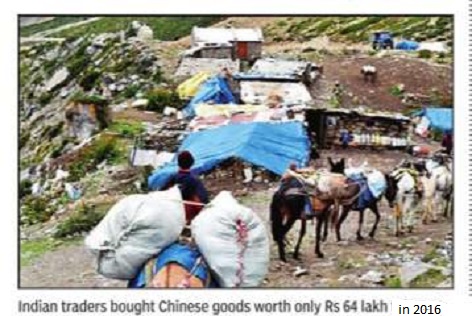China-India economic relations
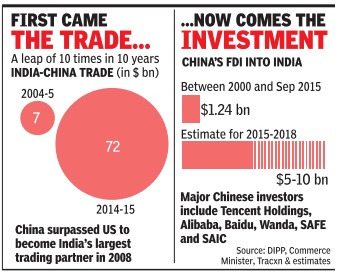
This is a collection of articles archived for the excellence of their content. |
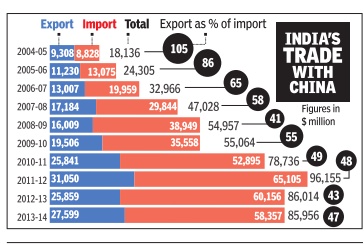
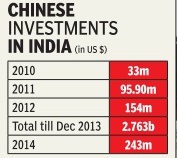
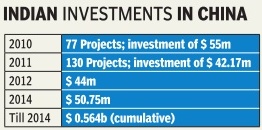
Contents |
Exports from China to India and India to China
2014-18: trade gap widens from $48bn to $53bn

From: Sidhartha, India to seek easier export rules to China, March 26, 2018: The Times of India
See graphic:
India-China trade, imports and exports- 2014-18
2015: India has a $3,540.5m deficit every month
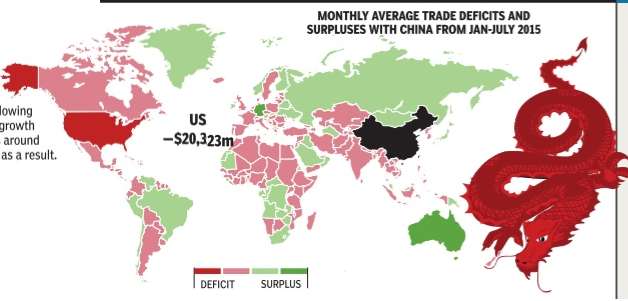
The Times of India, September 27, 2015
China's economy is slowing from its double digit growth and many economies around the world are reeling as a result.Its trade partners, including India, have seen once dependable surpluses wither away, or already existing deficits compound.India counts a $3,540.5m trade deficit on average a month, according to data clocked between January and July 2015
2016: China no.1 source of India's imports, no.4 destination for exports
Calls for boycotting Chinese goods don't sound practical in the present trade scenario. China is the largest source of India's imports while it is the fourth largest destination of our exports. Trade with India is a much smaller fraction of China's total trade volumes
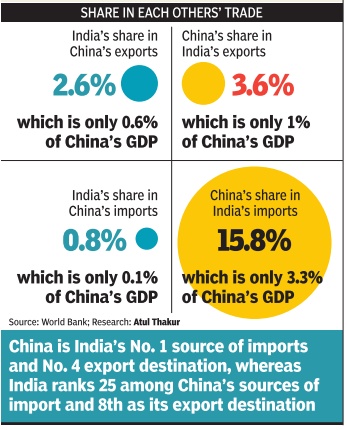
i) The imports of China and India from each other as a percentage of the other country’s GDP
The Times of India
Border trade
Sharp dip in imports/ 2016
Pithoragarh:
The cross-border trade at Taklakot mandi in Purang district of China's Tibet Autonomous Region where traders from Uttarakhand have traditionally been selling their wares has seen a sharp rise in Indian exports (Rs 5.86 crore) this year, while the Chinese goods they bring back after their five-month stay saw a slump as they amounted to just Rs 64 lakh.
This year saw a wide gap between exports and imports.In 2015, the trade volume with China through Lipulekh Pass was Rs 4.36 crore, of which Indian traders exported goods worth Rs 1.6 crore while imports from China were worth Rs 2.76 crore. In 2014, imports from the local Bhutia traders were worth Rs 2.14 crore, while they sold goods worth just Rs 1.9 crore.
Indian exports from the district include carpets, bamboo, matchboxes and packed sweets, while the traders bring back readymade garments, jackets and raw wool.“A total of 195 trade passes were issued this year, of which 77 were for traders and 118 were for helpers, but no Chinese traders came to the Indian mandi in Gunji,“ said P S Kutiyal, assistant trade officer.The final figures for this ye ar's trade can be calculated only after all the traders reach the Gunji mandi and pay their customs duty , he said.
The cross-border business takes place between June and October each year when traders make the journey across the 17,000-foot-high Lipulekh Pass to Purang. The trade time was extended by a month after traders petitioned to the government, saying early closure will lead to financial losses. “The trade for this year closed on October 31 as all the traders and helpers have come back from the Chinese mandi in Taklakot,“ said Kutiyal. The temporary branch of the SBI in Gunji has no facility of currency exchange.
“Absence of this facility makes the exchange rates costlier as traders have to pay Rs 11 for one Yuan, while the current rate is Rs 9.89 for a Yuan,“ said a trader. “We had submitted a memorandum to the central government and local trade officer to set up a currency exchange centre in SBI Gunji, but nothing has been done in this regard,“ said Garvuyal. Also the Chinese authorities do not allow transport animals like mules or horses after the Lipulekh Pass, which makes the products costly , as traders have to hire Chinese vehicles to carry their goods.
China's investment in Indian start-ups
2015, 2016
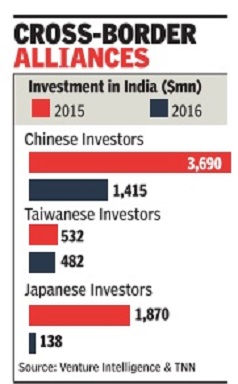
From: Other Asian firms' investment in startups nowhere close to China's, Nov 20 2016 : The Times of India
Other Asian firms' investment in startups nowhere close to China's, Nov 20 2016 : The Times of India
Chinese firms and funds have become big investors in Indian startups, and they are becoming particularly useful now as US funds slow down.Beijing Miteno Communication Technology , a Chinese tech conglomerate, made this year's biggest acquisition in the technology startup space -the $900 million buyout of Media.net, a subsidiary of Mumbai-based Directi, founded by brothers Bhavin and Divyank Turakhia.
Ecommerce giant Alibaba has made large investments in Paytm and Snapdeal. Didi Chuxing, the equivalent of Uber in China, has invested in Ola. Internet giant Tencent recently led a $175 million funding in messaging app Hike; prior to that, it led a $90 million round in healthcare solutions firm Practo and, through its joint venture with South Africa's Naspers, invested in online travel firm Ibibo Group.
“There are demographic similarities and both countries are seeing consumer growth for digital firms. Also, Chinese players have experience in market creation and running successful digital companies, so they can play a bigger role than being just financial investors,“ says Ashish Kashyap, founder of Ibibo, which last month merged with rival MakeMyTrip. Alibaba, for instance, is seen to be actively helping Paytm in various aspects.
Bhavin Turakhia says the Chinese understand the Indian market better than US companies do as the Indian market is on the same evolution path as that of China, but about five to 10 years behind. Chinese companies and funds have become big investors in Indian star tups. Cheetah Mobile, which owns products like Clean Master, invested in fitness app GOQii late last year.
Ctrip, one of China's largest online travel companies, invested $180 million in MakeMyTrip in January . China-based investment firm Hillhouse Capital has invested in Car Dekho. Smartphone maker Xiaomi led a $25-million funding round in content provider Hungama Digital Media Entertainment in April.
Web services company Baidu has said it is scouting for investment opportunities in Indian startups.
Even other Asian companies are nowhere close to investing as much as the Chinese in Indian startups. Japan's SoftBank and Singapore's Temasek are among the few non-Chi nese ones that have made investments. Taiwan's Foxconn has also made several investments, like in Qikpod, Hike and Snapdeal, but some see Foxconn as practically a Chinese company , given that much of its operations is in China.
What's pushing the Chinese tech companies to make large investments are two things: one, many of them are making big profits in their home market, thanks partly to the restrictions on foreign competi tion; and two, the Chinese economy is slowing down.
So they want to use their surpluses to expand into what is potentially the world's third largest digital market.
“There are only two big growing markets where they can invest: India and the United States. Silicon Valley does not respect Chinese capital. So the Indian tech sector becomes attractive to them,“ says Mohan Kumar, executive director at Norwest Ventures, a US-based venture fund that has opera tions in India. Kumar also notes that Chinese investors often value Indian startups at three to five times more than what other seasoned investors do. “So entrepreneurs naturally prefer them,“ he says.
Higher valuations mean the Chinese investors take lower stakes for the same amount of investment, and founders can hope for an even higher valuation in their next round of fund raising.
Language and politics are a challenge. May be for that reason, the Chinese are for now preferring partnerships and not outright buys. Even investment firms are building partnerships. Chinese VC fund Incapital has tied up with Indian fund IvyCap Ventures to enable its partner investors to have a closer look at potential investment opportunities in Indian startups.
China is showing interest in traditional industries too. In July 2016, Chinese pharma compa ny Shanghai Fosun Pharmaceutical Co acquired Indian injectables manufacturer Gland Pharma for $1.27 billion, and in August, Chinese conglomerate Jiangsu Longzhe Technology and Trade Development Co acquired Diamond Power Infrastructure, Vadodara-based manufacturer of cables, conductors, transformers and other power sector equipment, for $125 million. But digital technology looks to be where the biggest action is.
Imports from China
Statistics on imports from China
2018: The main items imported
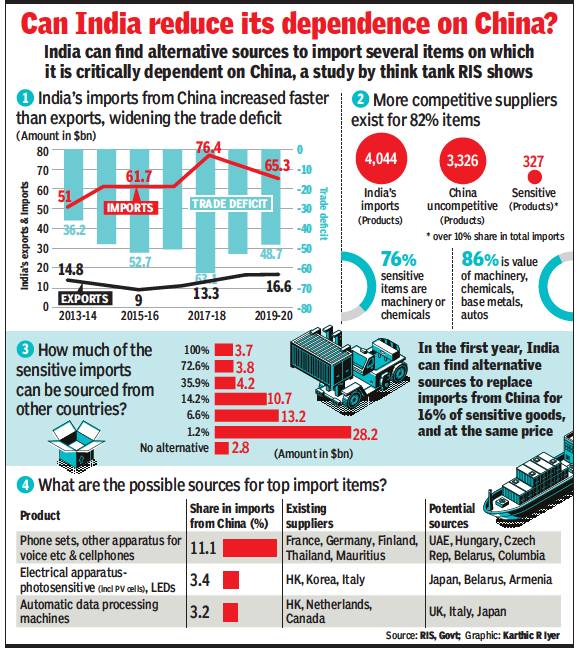
From: Sidhartha, 327 items form 3/4th of imports from China, ‘can be alternatively sourced’, August 10, 2020: The Times of India
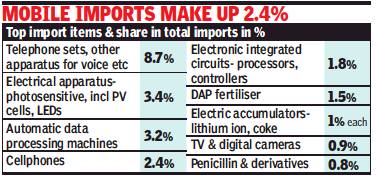
From: Sidhartha, 327 items form 3/4th of imports from China, ‘can be alternatively sourced’, August 10, 2020: The Times of India
Just 327 products — ranging from mobile phones and telecom equipment to cameras, solar panels, airconditioners and penicillin — accounted for nearly threefourths of the imports from China, a study has estimated, while pointing out that it is possible to find alternative sources to get these goods or manufacture them in India.
A paper by policy thinktank Research and Information System for Developing Countries used UN Comtrade data to estimate the value of these “critically sensitive imports” at $66.6 billion in 2018 in overall imports of a little over $90 billion. In 2018-19, official numbers had pegged imports from China at $76.4 billion.
A product was considered sensitive if China accounted for over 10% share of imports or if the value of shipments was $50 million or more. “Such export monopoly of China has to be diluted in view of strategic requirements,” the report said.
China not the most competitive producer in 82% imports: Study
A product was considered sensitive if China accounted for over 10% share of imports or if the value of shipments was $50 million or more. ‘Such export monopoly of China has to be diluted in view of strategic requirements,” the report by thinktank Research and Information System for Developing Countries said. In FY19, official numbers had pegged imports from China at $76.4 billion.
In terms of the number of goods imported from across the border, the share of the 327 sensitive products was less than 10% of the 4,000-odd items that were imported from China. The study, which was shared with TOI, estimated that in case of 82%, or over 3,300 products, China was not the most competitive producer.
But there are also products where China is the sole exporter. The product base ranges from everyday-use items such as earphones and headphones to microwave ovens and certain types of washing machines. The list also has several types of machinery, some auto components, escalator components, certain acids and chemicals and fertiliser like diammonium phosphate, where China is the sole supplier. “It is possible to produce some of the products domestically if other sources are not immediately available,” RIS director general Sachin Chaturvedi told TOI. The RIS paper suggested taking a strategic view while deciding on alternative sources for imports.
In fact, since March, the government has started tapping overseas missions to identify alternative sources of import of products. Economists and traders, however, point out that it may not be possible to find the products at the same scale, something that even the RIS report points to. “As China is empowered with scale factor, other competitors lose their grounds when delivery of voluminous trade takes place,” the study noted.
In recent years, China has emerged as the hub for the production of electronics, pharma and chemicals with global giants setting up manufacturing facilities to not just cater to the domestic market but export to other destinations, including the US and Europe. Following the outbreak of Covid-19, several companies are looking at de-risking their production chains by setting up or relocating facilities to other countries.
Impact of Chinese imports
2017-18: Chinese imports shut MSMEs down: Panel
Chinese imports shut MSMEs down: Panel, July 27, 2018: The Times of India
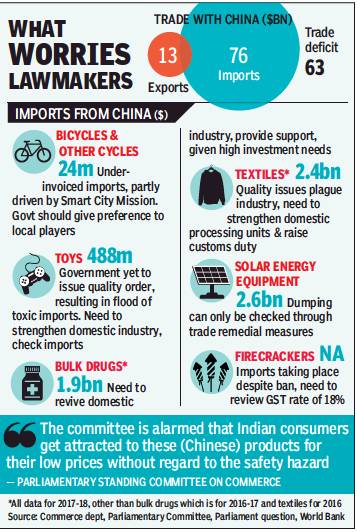
From: Chinese imports shut MSMEs down: Panel, July 27, 2018: The Times of India
Nearly 2L Jobs Lost In Solar Panel Sector
A Parliamentary panel asked the government to swiftly impose quality standards and check Chinese imports across several sectors — from toys and textiles to bulk drugs and bicycles — while noting that shipments from across the border have taken a toll on the domestic manufacturing sector and pushed several micro, small and medium enterprises (MSMEs) to shut shop.
“...India has been an easy dumping ground for Chinese goods on account of low price of Chinese goods, poor enforcement and porous border, both at sea and land,” the standing committee on commerce said in a report tabled in Parliament on Thursday. It said the US and the European Union have been “quite aggressive and agitated over the erosion of their domestic industry and loss of employment” and recommended that the government be more “proactive” in trade defence measures, such as anti-dumping and anti-subsidy actions, while imposing other restrictions.
The panel estimated that dumping of Chinese solar panels in India has resulted in nearly two lakh job losses. Similarly, it pointed out that a large quantity of under-invoiced bicycles were entering the Indian market due to “lax enforcement”. It cited the public bike sharing plan initiated by Smart City administrators as one of the reasons behind surge in shipments from China, which offered cheaper cycles.
Although Chinese goods have traditionally faced the highest anti-dumping action, the committee believes that they are “relatively few in comparison to the kind of dumping” that has taken place. “The impact of Chinese imports has been such that India is threatened to become a country of importers and traders with domestic factories either cutting down their production or shutting down completely,” it said.
Over the last few years, the government too has been worried about the widening trade deficit and is seeking that China open up its markets to more Indian goods to reduce the gap between imports and exports. Rice, meat, pharma and information technology are sectors where the government is seeking greater play for Indian companies in China, which has been reluctant to open up.
The fear of Chinese goods swamping the market has prompted the government to tread carefully on Regional Comprehensive Economic Partnership — the proposed free trade agreement involving India, China, Asean countries, Australia and New Zealand.
Besides, other countries have shown little interest in giving Indian software professionals, nurses and other service providers easier access to their markets. In a separate report, the panel slammed some of the provisions of the free trade agreement with Asean, such as services where even the government believes that the treaty is lopsided.
Indian goods sold in China
2017
HIGHLIGHTS
There is a lot of attraction for Indian foods and many other products all over China.
They are sold by hundreds of Chinese traders through online stores and physical shops.
Almost every city has a shop selling Indian goods, and some like Shanghai, Guangzhou, Yiwu and Beijing have 2-3 each.
Indian masalas are spicing up the Chinese palate like never before with large numbers of them buying Indian food products during the annual shopping event, the Singles Day.
The shopping carnival saw online markets doing business exceeding $30 billion as millions of consumers bought a wide range of goods, most of which are manufactured in China. Some foreign-made goods including those produced in India, Europe and the US were hawked and purchased.
Indian grocery items, ready-made food and Ayurvedic cosmetic brands like Amul, MDH Masala, Gits, Tata Tea, Haldiram, Dabur, Patanjali and Himalaya, were snapped up on Alibaba's Taobao.com, jd.com and several other Internet marketplaces.
The online market attracts a large chunk of the Chinese population with attractive discounts on the occasion, that is also known as 11/11 Singles day+ because it involves the repeated use of 1 or single four times. However, buyers include both married and singles. The 24-hour buying frenzy has emerged as the world's biggest shopping day eclipsing Black Friday and Cyber Monday in the United States.
Alibaba reported that its one-day sales reached $25.35 billion on Saturday, a rise of 39 percent from last year. The company said it had sold goods including apparel, mobile phones, imported lobster and infant formula from 140,000 brands during the day.
JD, which started the discount sales on November 1, said it had sold nearly $20 billion in goods over an 11-day period. It sold 55 million facial masks and 500,000 Thailand black tiger shrimps, JD said. There are several other online shopping firms which have not released all their figures yet.
"There is a lot of attraction for Indian foods and many other products all over China. They are sold by hundreds of Chinese traders through online stores and physical shops. Almost every city in China has a shop selling Indian goods, and some like Shanghai, Guangzhou, Yiwu and Beijing have two or three each," a Guangzhou-based Indian businessman told.
The most sought-after Indian goods are spices followed by cosmetics. Textiles and home decoration pieces are also on sale. Buyers include the vast community of expatriates including Indians, Pakistanis, Japanese, Arabs, Africans and even Europeans who are fond of curried food. More than a million expatriates live in different Chinese cities.
There are more than 100 physical stores selling Indian products in different Chinese cities. These shops, most of whom are run by local traders, also sell online. Indian products usually sell at a premium ranging from 100 percent to 300 percent over the printed prices but this does not deter buyers who want quality products from India.
"The quality of Indian spices like cardamom and cumin seeds is far superior in India as compared to those sold in local Chinese markets. People start realizing it once they use them. Turmeric has become very popular in China," the businessman said.
Chinese have emerged as the world's biggest international travellers, which has resulted in an enlarged worldview and a desire to taste the foods of different countries. Thousands of restaurants in Chinese cities now feature "chicken curry" on the menu. They use ready-made spice mixtures comprising turmeric and other Indian masalas. Many Chinese housewives also cook curry at home.
A wide range of packaged Indian sweets is also on sale at the online markets. They are mostly purchased by foreigners including Arabs, Europeans, and Americans with a sweet tooth because the average Chinese does not have an affinity for intensely sweet eatables.
The Singles Day has also given a boost to China's clout as an international hub for mobile payments and intelligent logistics, the local media quoted Matthew Crabbe, Asia Pacific research director at consultancy Mintel as saying. The Alipay mobile wallet saw deals at a peak rate of 256,000 transactions per second in China and many foreign countries, according to Alibaba. Robots and algorithms accelerated parcel distribution, it said.
Power sector
2016-20
NEW DELHI: The government move to keep Chinese companies out of power transmission and distribution (T&D) projects couldn’t have come any sooner. Industry data shows Chinese companies have been making steady inroads into the strategic sector, winning contracts for installing intelligent control systems in parts of the national grid and at least 46 city networks between August 2016 and March this year.
Chengdu-based Dongfang Electric Corporation, one of China’s ‘backbone enterprise groups’ directly administered by Beijing, alone bagged SCADA (supervisory control and data acquisition) contracts for 23 cities across five states and a Union Territory.
ZTT, Shenzen SDG Information Company and Tongguan Group together won 23 contracts from discoms and state-run PowerGrid, which operates the national transmission network, for installing real-time data acquisition system — also known as ‘reliable communication through optical ground wire’.
T&D networks form the backbone of any power system. SCADA and real-time communications systems are the nerve centres that make networks ‘smart’. That’s why sanctity of these systems are important for grid security.
“In connected systems, intelligent equipment talk to each other and exchange data and information, making the system more efficient but at the same time increasing the vulnerability if exposed to suspect individuals, companies and nations which may use such access to their advantage,” Indian Electrical Equipment Manufacturers’ Association director-general Sunil Misra told TOI.
The power ministry had on July 3 banned equipment imports from China without permission. It also mandated imported T&D equipment be tested at designated laboratories for embedded malware or spyware — a common perception about Chinese gear.
The move, even though part of economic retaliation against China’s border transgressions in Ladakh, marked an acknowledgement of possible vulnerabilities with Chinese equipment.
IEEMA had written to the national security adviser and the ministry in 2017 to point out India’s transmission system becoming vulnerable to hacking due to expanding Chinese footprint.
Later that year, the state power ministers conference decided to conduct a countrywide cyber security audit of T&D systems.
These warnings followed protests over Chinese companies bagging a slew of big-ticket contracts for power station hardware as India rushed to ramp up generation capacity.
